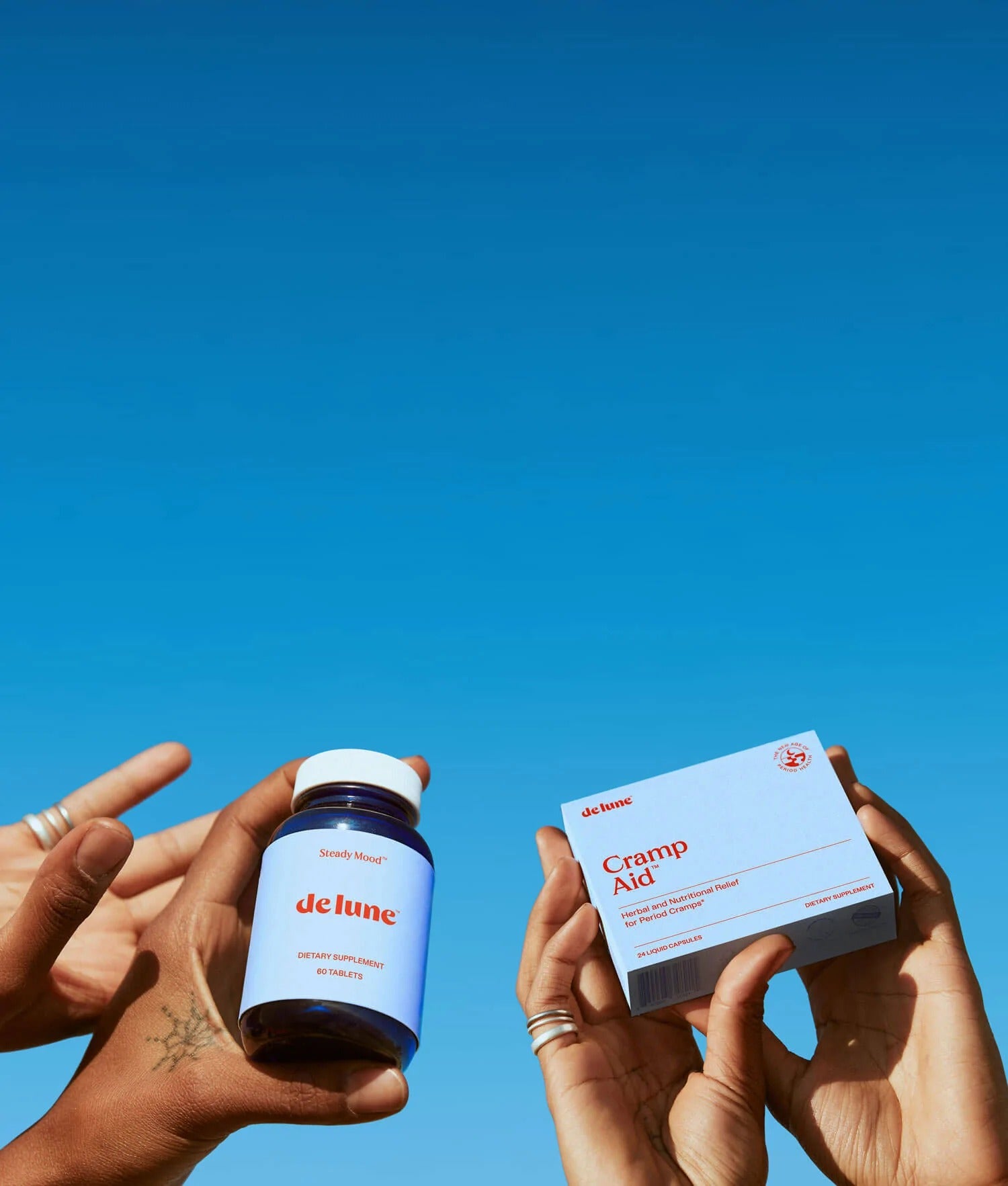Dysmenorrhea is the clinical term for period pain. It’s a common—and often debilitating—gynecological condition that affects between 45% and 95% of menstruating women.1 Despite its high prevalence, dysmenorrhea is often poorly treated, and even disregarded, by health professionals and pain researchers.
While many menstruating people accept pain as a normal part of the cycle, it doesn’t have to be that way. Dysmenorrhea is treatable, and period with periods have options for managing their pain.
Can Zinc Help Relieve Dysmenorrhea & Reduce Period Pain Symptoms?
Before we get into the specifics of zinc and dysmenorrhea, some basics on why humans need zinc and how it interacts with the body.
Zinc is an important nutrient that’s required to stay healthy. It’s found in virtually all tissues and fluids in the body.2
Approximately 300 different enzymes require zinc to work properly.3 At the molecular level, zinc is involved in basic, life-supporting processes. Zinc helps:
- Make proteins and DNA
- Remove substances that contribute to aging
- Fend off invading bacteria and viruses4,5,6
Put simply, zinc is a critical element of your skin, teeth, bones, hair, nails, muscles, and brain.7
A zinc deficiency would affect a number of body parts, including the nervous system, gastrointestinal tract, immune system, and reproductive system.8 Without zinc:
- Wounds wouldn’t heal properly9
- Your brain would feel sluggish5
- Your sense of taste and smell would be impaired10
Zinc is an essential nutrient. This means the body cannot make it on its own, so it must come from food or supplements. Overall, having too little zinc is far more common than having too much.11 It’s estimated that up to one-fifth of the world’s population is zinc deficient.7,12
To understand how zinc works to relieve dysmenorrhea, it’s helpful to understand what causes dysmenorrhea in the first place.
Remember that the uterus is a mostly-muscular organ capable of serious contractions (case in point: childbirth). The root cause of dysmenorrhea is the build-up of prostaglandins—tiny compounds that have hormone-like effects in the body.
When prostaglandins accumulate in the uterus, they trigger the uterine muscles to contract, or tighten up. When these muscles contract very strongly, they can press against nearby blood vessels that deliver oxygen to the uterus. Because muscles need oxygen to function, depriving uterine muscles of oxygen is painful, and results in cramping.13
The pro-inflammatory prostaglandins that live in a painful uterus are called PgF2-alpha and PgE2. Levels of these prostaglandins are low throughout most of the menstrual cycle, then they rise sharply before a women’s period begins. Studies have found that women with dysmenorrhea produce 8 to 13 times more of these prostaglandins than women without dysmenorrhea.14,15
There are a number of working hypothesis for how zinc reduces dysmenorrhea. Some studies show that zinc can inhibit the production of the PgE2 prostaglandins that cause period pain in the first place.16,17,18 This is similar to the way that Non-Steroidal Anti-Inflammatory Drugs (NSAIDs) like Advil, aspirin, and ibuprofen work.15

Other researchers hypothesize that zinc improves the circulation of blood to the uterus, thus preventing the cut-off of oxygen to uterine muscles and the painful cramps that follow.19 Zinc’s powerful antioxidant and anti-inflammatory properties may be responsible for boosting blood flow.20,21 By reducing inflammatory agents in the bloodstream, blood and oxygen are better able to reach the uterus and prevent cramps.17
Whatever the mechanism, research suggests that zinc really does reduce period pain. While there aren’t a huge number of studies investigating zinc and dysmenorrhea, all that have reported positive results.
- In 1982, a study involving 66 participants looked at the therapeutic effects of zinc lozenges on the common cold. While this study didn’t set out to examine dysmenorrhea, it ended up doing that anyway. After the study, a physician asked the female participants if the experiment caused any menstrual abnormalities. The women who took the zinc lozenges explained that their periods started on time, but they did not experience any menstrual cramping, bloating, or any other symptom to warn them of their pending periods. These comments only came from those who took zinc, and not the placebo group.17,22
- In 2014, researchers gave 56 young women with dysmenorrhea zinc supplements for two menstrual cycles. Significant reductions in pain occurred during first cycle. Pain scores took an even deeper dive—by as much as 50%— during the second cycle, suggesting zinc is more effective when taken for longer periods of time.23
- 2015 was a good year for dysmenorrhea research. Three high-quality studies were published this year, involving a total of nearly 400 women with dysmenorrhea.
- Zekavat and colleagues found that women who supplemented with zinc experienced significant reductions in pain duration and severity. The longer women took a zinc supplement, the lower the severity of their pain.24
- Sangestani and colleagues also reported significant reductions in period pain and menstrual bleeding in women who took a zinc supplement. These women also reported fewer headaches, and less severe muscle pain, vertigo, and weakness.25
- Teimoori and colleagues concluded that using a zinc supplement in combination with painkiller drugs was better at treating dysmenorrhea than painkillers alone.15
Zinc Can Also Help With Other Period Symptoms Like PMS
The benefits of zinc may not stop at reducing pain, and may help reduce other mood-related PMS symptoms as well.
Numerous studies have reported that zinc levels fluctuate with each phase of the menstrual cycle.26,27,28,29 Zinc levels seem to be lowest during the luteal phase26—the phase just before menstruation, when PMS symptoms occur.30
Some researchers think the lack of zinc may alter the balance of hormones and neurotransmitters in the brain, which affects thoughts, emotions, and mental health.31,32 Not surprisingly, one study found that women suffering from PMS had lower zinc levels compared to those without PMS.31
Should You Supplement With Zinc to Help Prevent Dysmenorrhea, PMS & Cramps?
Considering the linkage between zinc and pain-free periods, should you take a zinc supplement? It depends. If you fall into one or more of these categories, you’ll likely benefit from more zinc.
1. If you avoid animal foods
The best sources of dietary zinc are animal foods like shellfish, beef, pork, chicken, and dairy products.33 Red meat and poultry provide the majority of zinc in the American diet.4
Some plant foods like beans, oatmeal, and fortified breakfast cereals contain zinc as well, though their zinc content is much lower compared to animals foods.33 To add insult to injury, the zinc found in plants foods is very difficult to absorb. Phytates, also known as phytic acid, are plant compounds found in whole grains and legumes. Phytates act as ‘anti-nutrients’—they tightly bind to zinc in the GI tract and prevent it from being absorbed into the blood.34,35
Because of this absorption issue, vegans, vegetarians, and those who limit their consumption of meat, shellfish, and dairy products are susceptible to zinc deficiency. Research shows that serum zinc levels are lower in those who follow a vegetarian diet, and are lower in female vegetarians compared to male vegetarians.36
Our bodies don’t have any special storage system for zinc, so getting a steady intake is important.4 This means meeting the Recommended Daily Allowance (RDA) most days. Women 9-13 years old and women 19 years and older need 8mg of zinc each day; women 14-18 years need 9mg.4 For vegans and vegetarians, meeting these levels is nearly impossible without a supplement.
2. If you take birth control pills or other medications
Studies show that oral contraceptives (i.e. birth control pills) put users at risk of a number of nutrient deficiencies,37 including zinc.29 Women who take oral contraceptives have been shown to have lower levels of zinc in their blood, and lose more zinc in their urine.26
Other types of medications may contribute to low zinc levels as well. If you take antibiotic, penicillamine, or diuretic drugs on a regular basis, ask your doctor if you should supplement with zinc. These drugs may interfere with zinc absorption, or increase the amount of zinc lost in urine.4
3. If you just want to cover your nutritional bases
Getting an accurate read on the body’s zinc levels is tricky. Currently, the best way to determine someone’s zinc levels is to check the amount of zinc in the serum—the watery, protein-rich component of blood. While this method is good at identifying zinc deficiency in large groups of people, some experts say it’s not a valid or reliable measure for identifying zinc deficiency in individuals.8
This is because serum zinc always seems to be in flux. The amount of zinc in the serum can vary as much as 20% in a 24-hour period, depending on the time of the day your doctor took your blood sample and what you ate that day.38 Because of these difficulties in measurement, less-than-optimal zinc levels are more likely to fly under your doctor’s radar.
Many people find that supplementation is good peace of mind, just to be certain that all nutrient bases are covered. About 27% of the US population takes supplements containing zinc.39
4. If you’re trying to manage period pain
While the Recommended Daily Allowance (RDA) of zinc is sufficient to maintain general health, research suggests this is not enough zinc to significantly relieve dysmenorrhea.17
Studies show it takes at least 30mg of zinc a day—over three times the RDA—to relieve PMS and dysmenorrhea.17 One would have to eat about 3/4 of a pound of crab, a pound of beef, 2 pounds of chicken or pork, or 18 cups of yogurt to achieve this amount.33 That's a lot of food, especially considering crab, beef, chicken, pork, and yogurt are among the best food sources of zinc. Supplements offer a convenient, sustainable, and cruelty-free way to achieve a therapeutic dose of zinc.
Why De Lune?
Although a growing body of evidence points to zinc as a safe and effective option for dysmenorrhea relief, conditions like dysmenorrhea are often best treated through multiple modes of action. Even when taken in therapeutic doses, relying on just one method of treatment, like zinc, may not be enough to eliminate period pain or PMS in some people.
We combined the most effective nutrients and herbs for period pain and PMS in Cramp Aid—high-potency relief for period cramps—and Steady Mood—daily support for PMS mood swings and stress. Because of zinc's dual role in both period pain and PMS relief, find this essential period nutrient in our Period Rescue Kit, which includes both Cramp Aid and Steady Mood at our best bundled price.
References
1. Proctor, M., & Farquhar, C. (2006). Diagnosis and management of dysmenorrhoea. BMJ: British Medical Journal, 332(7550), 1134.
https://www.ncbi.nlm.nih.gov/pmc/articles/PMC1459624/
2. http://www.fao.org/docrep/004/y2809e/y2809e0m.htm
3. Prasad, A. S. (1996). Zinc deficiency in women, infants and children. Journal of the American College of Nutrition, 15(2), 113-120.
https://www.tandfonline.com/doi/abs/10.1080/07315724.1996.10718575
4. https://ods.od.nih.gov/factsheets/Zinc-HealthProfessional/#en10
5. Prasad, A. S. (1995). Zinc: an overview. Nutrition (Burbank, Los Angeles County, Calif.), 11(1 Suppl), 93-99.
http://europepmc.org/abstract/med/7749260
6. Solomons, N. W. (1998). Mild human zinc deficiency produces an imbalance between cell-mediated and humoral immunity. Nutrition reviews, 56(1), 27-28.
https://academic.oup.com/nutritionreviews/article-abstract/56/1/27/1834996
7. Bhowmik, D., Chiranjib, K. P., & Kumar, S. (2010). A potential medicinal importance of zinc in human health and chronic. Int J Pharm, 1(1), 05-11.
https://www.researchgate.net/profile/Debjit_Bhowmik4/publication/277014212_A_potential_medicinal_importance_of_zinc_in_human_health_and_chronic_disease/links/555ec6ea08ae86c06b5f4d7f.pdf
8. Roohani, N., Hurrell, R., Kelishadi, R., & Schulin, R. (2013). Zinc and its importance for human health: An integrative review. Journal of research in medical sciences: the official journal of Isfahan University of Medical Sciences, 18(2), 144.
https://www.ncbi.nlm.nih.gov/pmc/articles/PMC3724376/
9. Alieva, T. U., Fedorov, S. V., & Sviridov, S. V. (2010). Blood plasma zinc and copper concentrations in patients with purulent soft tissue wounds. Anesteziologiia i reanimatologiia, (3), 8-12.
http://europepmc.org/abstract/med/20734839
10. Prasad, A. S., Beck, F. W., Grabowski, S. M., Kaplan, J., & Mathog, R. H. (1997). Zinc deficiency: changes in cytokine production and T-cell subpopulations in patients with head and neck cancer and in noncancer subjects. Proceedings of the Association of American Physicians, 109(1), 68-77.
http://europepmc.org/abstract/med/9010918
11. Plum, L. M., Rink, L., & Haase, H. (2010). The essential toxin: impact of zinc on human health. International journal of environmental research and public health, 7(4), 1342-1365.
http://www.mdpi.com/1660-4601/7/4/1342/htm
12. Wessells, K. R., & Brown, K. H. (2012). Estimating the global prevalence of zinc deficiency: results based on zinc availability in national food supplies and the prevalence of stunting. PloS one, 7(11), e50568.
http://journals.plos.org/plosone/article?id=10.1371/journal.pone.0050568
13. https://my.clevelandclinic.org/health/diseases/4148-dysmenorrhea
14. Hudson, T. (2007). Women's Encyclopedia of Natural Medicine: Alternative Therapies and Integrative Medicine for Total Health and Wellness. MACMILLAN HEINEMANN.
https://www.amazon.com/Womens-Encyclopedia-Natural-Medicine-Alternative/dp/0071464735
15. Teimoori, B., Ghasemi, M., Hoseini, Z. S. A., & Razavi, M. (2016). The efficacy of zinc administration in the treatment of primary dysmenorrhea. Oman medical journal, 31(2), 107.
https://www.ncbi.nlm.nih.gov/pmc/articles/PMC4861396/
16. Fong, L. Y., Zhang, L., Jiang, Y., & Farber, J. L. (2005). Dietary zinc modulation of COX-2 expression and lingual and esophageal carcinogenesis in rats. Journal of the National Cancer Institute, 97(1), 40-50.
https://academic.oup.com/jnci/article/97/1/40/2521240
17. Eby, G. A. (2007). Zinc treatment prevents dysmenorrhea. Medical hypotheses, 69(2), 297-301.
https://pdfs.semanticscholar.org/eaf1/1169f0e6d32572fd6a01308c839cd62850d7.pdf
18. Kelly, R. W., & Abel, M. H. (1983). Copper and zinc inhibit the metabolism of prostaglandin by the human uterus. Biology of reproduction, 28(4), 883-889.
https://academic.oup.com/biolreprod/article/28/4/883/2766289
19. Eby, G. A., & Halcomb, W. W. (2006). High-dose zinc to terminate angina pectoris: a review and hypothesis for action by ICAM inhibition. Medical hypotheses, 66(1), 169-172.
http://citeseerx.ist.psu.edu/viewdoc/download?doi=10.1.1.539.7755&rep=rep1&type=pdf
20. Prasad, A. S., Bao, B., Beck, F. W., Kucuk, O., & Sarkar, F. H. (2004). Antioxidant effect of zinc in humans. Free Radical Biology and Medicine, 37(8), 1182-1190.
https://www.sciencedirect.com/science/article/pii/S0891584904005465
21. Prasad, A. S. (2008). Clinical, immunological, anti-inflammatory and antioxidant roles of zinc. Experimental gerontology, 43(5), 370-377.
https://www.sciencedirect.com/science/article/pii/S0531556507002458
22. Eby, G. A., Davis, D. R., & Halcomb, W. W. (1984). Reduction in duration of common colds by zinc gluconate lozenges in a double-blind study. Antimicrobial agents and chemotherapy, 25(1), 20-24.
http://aac.asm.org/content/25/1/20.full.pdf
23. Kashefi, F., Khajehei, M., Tabatabaeichehr, M., Alavinia, M., & Asili, J. (2014). Comparison of the effect of ginger and zinc sulfate on primary dysmenorrhea: a placebo-controlled randomized trial. Pain Management Nursing, 15(4), 826-833.
https://www.researchgate.net/profile/Marjan_Khajehei/publication/260373278_Comparison_of_the_Effect_of_Ginger_and_Zinc_Sulfate_on_Primary_Dysmenorrhea_A_Placebo-Controlled_Randomized_Trial/links/59fb8890a6fdcca1f2920653/Comparison-of-the-Effect-of-Ginger-and-Zinc-Sulfate-on-Primary-Dysmenorrhea-A-Placebo-Controlled-Randomized-Trial.pdf
24. Zekavat, O. R., Karimi, M. Y., Amanat, A., & Alipour, F. (2015). A randomised controlled trial of oral zinc sulphate for primary dysmenorrhoea in adolescent females. Australian and New Zealand Journal of Obstetrics and Gynaecology, 55(4), 369-373.
https://obgyn.onlinelibrary.wiley.com/doi/full/10.1111/ajo.12367
25. Sangestani, G., Khatiban, M., Marci, R., & Piva, I. (2015). The positive effects of zinc supplements on the improvement of primary dysmenorrhea and premenstrual symptoms: a double-blind, randomized, controlled trial. Journal of Midwifery and Reproductive Health, 3(3), 378-384.
http://jmrh.mums.ac.ir/?_action=articleInfo&article=4463
26. Hess, F. M., King, J. C., & Margen, S. (1977). Zinc excretion in young women on low zinc intakes and oral contraceptive agents. The Journal of nutrition, 107(9), 1610-1620.
https://www.researchgate.net/profile/Janet_King2/publication/22261300_Zinc_Excretion_in_Young_Women_on_Low_Zinc_Intakes_and_Oral_Contraceptive_Agents/links/55db1c8808aec156b9af0b3e/Zinc-Excretion-in-Young-Women-on-Low-Zinc-Intakes-and-Oral-Contraceptive-Agents.pdf
27. Hagenfeldt, K., Plantin, L. O., & Diczfalusy, E. (1970). Trace elements in the human endometrium: zinc copper manganese sodium and potassium concentrations at various phases of the normal menstrual cycle. Acta endocrinologica, 65(3), 541-551.
https://www.popline.org/node/469534
28. Deuster, P. A., Dolev, E., Bernier, L. L., & Trostmann, U. H. (1987). Magnesium and zinc status during the menstrual cycle. American journal of obstetrics and gynecology, 157(4), 964-968.
https://www.sciencedirect.com/science/article/pii/S0002937887800960
29. Hahn, N., Paschen, K., & Haller, J. (1972). Serum levels of copper iron magnesium calcium and zinc in women with a normal menstrual cycle under treatment with ovulation inhibitors and during pregnancy. Archiv fuer Gynaekologie, 213(2), 176-186.
https://www.ncbi.nlm.nih.gov/pubmed/4678746
30. http://www.arhp.org/Publications-and-Resources/Quick-Reference-Guide-for-Clinicians/PMS/signs
31. Chuong, C. J., & Dawson, E. B. (1994). Zinc and copper levels in premenstrual syndrome. Fertility and sterility, 62(2), 313-320.
https://www.fertstert.org/article/S0015-0282(16)56884-8/pdf?code=fns-site
32. Stengaard‐Pedersen, K. (1982). Inhibition of enkephalin binding to opiate receptors by zinc ions: possible physiological importance in the brain. Basic & Clinical Pharmacology & Toxicology, 50(3), 213-220.
https://onlinelibrary.wiley.com/doi/abs/10.1111/j.1600-0773.1982.tb00964.x
33. U.S. Department of Agriculture, Agricultural Research Service. 2011. USDA National Nutrient Database for Standard Reference, Release 24. Nutrient Data Laboratory Home Page.
http://www.ars.usda.gov/ba/bhnrc/ndl
34. Hambidge, K. M., Miller, L. V., & Krebs, N. F. (2011). Physiological requirements for zinc. International Journal for Vitamin and Nutrition Research, 81(1), 72.
https://www.ncbi.nlm.nih.gov/pmc/articles/PMC4495350/
35. Wise, A. (1995). Phytate and zinc bioavailability. International journal of food sciences and nutrition, 46(1), 53-63.
https://www.tandfonline.com/doi/abs/10.3109/09637489509003386
36. Foster, M., Chu, A., Petocz, P., & Samman, S. (2013). Effect of vegetarian diets on zinc status: a systematic review and meta‐analysis of studies in humans. Journal of the Science of Food and Agriculture, 93(10), 2362-2371.
https://www.fasebj.org/doi/abs/10.1096/fasebj.28.1_supplement.1043.1
37. Wynn, V. (1975). Vitamins and oral contraceptive use. The Lancet, 305(7906), 561-564.
https://www.sciencedirect.com/science/article/pii/S0140673675915706
38. Hambidge, K. M., Goodall, M. J., Stall, C., & Pritts, J. (1989). Post-prandial and daily changes in plasma zinc. Journal of trace elements and electrolytes in health and disease, 3(1), 55-57.
http://europepmc.org/abstract/med/2535321
39. Bailey, R. L., Gahche, J. J., Lentino, C. V., Dwyer, J. T., Engel, J. S., Thomas, P. R., ... & Picciano, M. F. (2010). Dietary Supplement Use in the United States, 2003–20061. The Journal of nutrition, 141(2), 261-266.
https://academic.oup.com/jn/article/141/2/261/4743341








